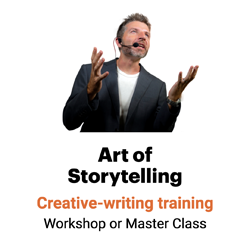Creative copy can attract or distract
“Prose is architecture. It’s not interior design.”
— Ernest Hemingway, Nobel Prize-winning novelist

Study after study shows that when you add interesting, concrete details to your message, people remember them — sometimes to the exclusion of less fascinating, more abstract ideas.
But the power to attract may also distract readers from your main idea. If your “seductive details” don’t illustrate your key points, they can:
- Draw attention away from more important ideas (Luftig & Greeson, 1983)
- Disrupt text processing (Garner, Gillingham & White, 1989)
- Cause readers to forget the important information while remembering the interesting stuff (Baird & Hidi, 1984)
“Interesting but unimportant information frequently disrupts the learning of more important ideas,” writes Suzanne Hidi, associate member, Ontario Institute for Studies in Education, Centre for Applied Cognitive Science.
‘The seditious dealings of seductive details’
Indeed, say two researchers at Texas A&M University.
Ernest T. Goetz and Mark Sadoski reviewed the literature on “the seductive detail” and found these problems with that assumption.
| Study finds … | But … | So you should … |
| Readers who read a three-paragraph message with three extra sentences of colorful details remembered fewer of the main ideas than those who read the message without the extra sentences. (Hidi & Baird, 1988) | By adding three extra sentences, the researchers made the message 40% longer. The longer a message gets, the less readers remember, so it only makes sense that they remembered less of the longer piece than the shorter one. Plus, sticking three extra sentences into a coherent argument may make it less lucid. (Goetz & Sadoski, 1995) | Make room for concrete details by editing out some of the blah-blah from your message. By my estimation, abstract background information makes up nearly half of most organizational messages is. Get rid of that, and you’ll make your piece shorter and more colorful. |
| Participants read one of three versions of a message: 1) One with colorful details that signaled the main ideas with the italicized word Important; 2) one with colorful details and no signaling; 3) one with no color and no signaling.
Those who read the text with colorful details and no signaling remembered fewer of the main ideas than those with no colorful details that signaled the main ideas. (Hidi, Baird & Hildyard, 1982) |
Which came first: the signaling or the color? It’s impossible to know whether the lack of signaling or the colorful details made the difference. (Goetz & Sadoski, 1995) | Why choose between color and “signaling”? The best writers use display copy to lift the main ideas off the page and help readers learn and remember your key messages.
And … we can certainly do better than labeling key information Important. |
| Participants who read a passage about theoretical physicist Stephen Hawking with an opening paragraph about Hawking’s brilliant career and tragic health understood and remembered as many of the main ideas — about such topics as the Grand Unification Theory — as those who read the more abstract, “boring” version. (Garner & Gillingham,1991) | That’s no surprise. People remember concrete sentences and paragraphs about historical figures 200% to 300% better than abstract sentences and paragraphs. Moreover, people remembered an abstract sentence 70% more when it’s preceded with a concrete sentence than when it’s introduced by an abstract sentence.
Researchers call this the “conceptual peg hypothesis,” which means that concrete information serves as a mental peg on which readers hang related information to use later. (Goetz & Sadoski, 1993) |
Show and tell, then show and tell, then show and tell, then do it again.
The feature-style story structure begins with a concrete lead. And weaving concrete and abstract sentences makes for a story that moves from meaning to interest and back again. So write like a rollercoaster, riding up and down the hierarchy of abstraction. Give your readers a concrete peg to hang your important abstract information on. |
So are readers being “bewitched by distracting details, bothered by incoherent text or bewildered by incomprehensible abstractions?” the researchers ask.
Not on your watch. Instead of adding irrelevant but colorful details, illustrate your important points with relevant concrete details. Make the important interesting, and people will remember your message — main points as well as colorful details — for far longer than if you bored them to death with important abstraction.
Avoid ‘Visual Vampires.’
Call these interesting but unimportant elements “Visual Vampires.” That’s PreTesting’s term for images that attract audience members in television ads but that don’t draw them to the product.
PreTesting is a Tenafly, N.J., company that gauges consumers’ reactions to ads by measuring their “saccadic” eye movements, or how fast their eyes vibrate.
Ads featuring men with wacky, red, pigtail wigs (Wendy’s), dogs wearing dentures (Citi) and an exotic woman stretching (Hormel) all grabbed attention. But they failed to keep it long enough to for viewers to read the copy or hear about the products.
Build an argument.
So take a tip from Hemingway. Ask, are your creative elements architecture, helping you build your argument? Or are they interior design, just putting wallpaper over your message?
If they’re interior design, they could be distracting readers from your key ideas. Instead, support your abstract, important ideas with concrete, interesting material.
Remember: It’s not enough to make your copy interesting. Our job is to, in the words of James Fallows, national correspondent for The Atlantic Monthly, “make the important interesting.”
___
Sources: Suzanne Hidi, “Interest and Its Contribution as a Mental Resource for Learning,” Review of Educational Research, Winter 1990, Vol. 60, No. 4, pp. 549-571
Kenneth Hein, “Beware of Visual Vampires, Warns Measurement Firm,” Brandweek, Nov. 26, 2007

Leave a Reply